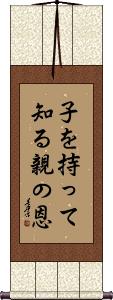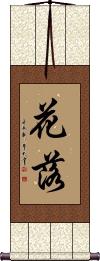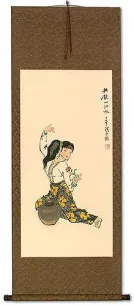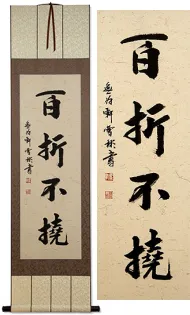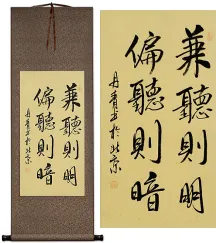Many custom options...
And formats...

The name Comes in Chinese / Japanese...
Buy a Comes calligraphy wall scroll here!
Personalize your custom “Comes” project by clicking the button next to your favorite “Comes” title below...
No man knows what he owes to his parents until he comes to have children of his own
子を持って知る親の恩 literally translates as: Only after you have a baby, you would appreciate your parents (feel the way they do, etc).
This is a bit like the “walk a mile in another man's shoes” saying. Basically, it's about you cannot fully understand the plight of others until you experience it yourself. It also shows appreciation for the plight of parents.
This Japanese proverb can also be translated a few more ways:
No man knows what he owes to his parents till he comes to have children of his own.
One knows not what one owes to one's parents till one comes to have children of one's own.
Only after you have a baby, you will appreciate your parents or feel the way they do.
Only after becoming a parent yourself do you realize how much you owe [how indebted you are] to your own parents.
Note: Because this selection contains some special Japanese Hiragana characters, it should be written by a Japanese calligrapher.
Flowers Fall / The End Comes
花落 means flower fall (closes and loses its petals).
It suggests nearing the end of something. A time that some might call “The sunset of life.” 花落 often follows 花開 or “flower open” to talk of the cycle of life.
We offer this as a possible companion to a “flower open” scroll (to be placed side by side or at either side of a doorway to say “things come and go” - a cool metaphor for a doorway). If placed in a doorway, it could be used to suggest to your guests that things bloom when they arrive through your door but wither when they leave (a great compliment).
See Also: Flowers Bloom
Wisdom comes from Experience
You can translate this 不经一事不长一智 Chinese proverb in a couple of ways.
The first is: You cannot gain knowledge without practice.
The second, and perhaps more popular way is: Wisdom comes from experience.
It literally means if you are inattentive to your affairs or situations you encounter, you will not gain or grow any wisdom or intellect.
Wisdom comes from Experience
不經一事 means “You can't gain knowledge without practical experience.”
This is the short form (first half) of a longer Chinese proverb. These 4 characters remind you that wisdom only comes from experience.
This in-stock artwork might be what you are looking for, and ships right away...
Gallery Price: $85.00
Your Price: $46.88
Gallery Price: $300.00
Your Price: $109.88
Gallery Price: $300.00
Your Price: $109.88
Gallery Price: $240.00
Your Price: $98.88
Gallery Price: $150.00
Your Price: $99.88
Gallery Price: $61.00
Your Price: $33.88
Gallery Price: $61.00
Your Price: $33.88
Gallery Price: $100.00
Your Price: $59.88
Gallery Price: $72.00
Your Price: $39.88
Not the results for comes that you were looking for?
Below are some entries from our dictionary that may match your comes search...
| Characters If shown, 2nd row is Simp. Chinese |
Pronunciation Romanization |
Simple Dictionary Definition |
四諦 四谛 see styles |
sì dì si4 di4 ssu ti shitai したい |
More info & calligraphy: Four Noble Truths (Buddhism){Buddh} (See 苦集滅道) The Four Noble Truths catvāri-ārya-satyāni; 四聖諦; 四眞諦. The four dogmas, or noble truths, the primary and fundamental doctrines of Śākyamuni, said to approximate to the form of medical diagnosis. They are pain or 'suffering, its cause, its ending, the way thereto; that existence is suffering, that human passion (taṇhā, 欲 desire) is the cause of continued suffering, that by the destruction of human passion existence may be brought to an end; that by a life of holiness the destruction of human passion may be attained'. Childers. The four are 苦, 聚 (or 集), 滅, and 道諦, i. e. duḥkha 豆佉, samudaya 三牟提耶, nirodha 尼棲陀, and mārga 末加. Eitel interprets them (1) 'that 'misery' is a necessary attribute of sentient existence'; (2) that 'the 'accumulation' of misery is caused by the passions'; (3) that 'the 'extinction' of passion is possible; (4) mārga is 'the doctrine of the 'path' that leads to the extinction of passion'. (1) 苦 suffering is the lot of the 六趣 six states of existence; (2) 集 is the aggregation (or exacerbation) of suffering by reason of the passions; (3) 滅 is nirvana, the extinction of desire and its consequences, and the leaving of the sufferings of mortality as void and extinct; (4) 道 is the way of such extinction, i. e. the 八正道 eightfold correct way. The first two are considered to be related to this life, the last two to 出世間 a life outside or apart from the world. The four are described as the fundamental doctrines first preached to his five former ascetic companions. Those who accepted these truths were in the stage of śrāvaka. There is much dispute as to the meaning of 滅 'extinction' as to whether it means extinction of suffering, of passion, or of existence. The Nirvana Sutra 18 says that whoever accepts the four dogmas will put an end to births and deaths 若能見四諦則得斷生死 which does not of necessity mean the termination of existence but that of continued transmigration. v. 滅. |
如來 如来 see styles |
rú lái ru2 lai2 ju lai nyorai にょらい |
More info & calligraphy: Tathagata(out-dated kanji) Tathagata; perfected one (suffix of high-ranking Buddhist deities) tathāgata, 多陀阿伽陀 q. v.; 怛他揭多 defined as he who comes as do all other Buddhas; or as he who took the 眞如 zhenru or absolute way of cause and effect, and attained to perfect wisdom; or as the absolute come; one of the highest titles of a Buddha. It is the Buddha in his nirmāṇakāya, i. e. his 'transformation' or corporeal manifestation descended on earth. The two kinds of Tathāgata are (1) 在纏 the Tathāgata in bonds, i. e. limited and subject to the delusions and sufferings of life, and (2) 出纏 unlimited and free from them. There are numerous sutras and śāstras bearing this title of 如來 rulai. |
不經一事 不经一事 see styles |
bù jīng yī shì bu4 jing1 yi1 shi4 pu ching i shih |
More info & calligraphy: Wisdom comes from Experience |
驕兵必敗 骄兵必败 see styles |
jiāo bīng bì bài jiao1 bing1 bi4 bai4 chiao ping pi pai kyouheihippai / kyohehippai きょうへいひっぱい |
More info & calligraphy: Pride Goes Before a Fall(expression) (yoji) defeat is inevitable for an overconfident army; being arrogant and overconfident inevitably leads to defeat; pride comes before a fall |
黎明前的黑暗 see styles |
lí míng qián de hēi àn li2 ming2 qian2 de5 hei1 an4 li ming ch`ien te hei an li ming chien te hei an |
More info & calligraphy: The Night is Darkest Before the Dawn |
猿も木から落ちる see styles |
sarumokikaraochiru さるもきからおちる |
More info & calligraphy: Even Monkeys Fall From Trees |
下家 see styles |
xià jiā xia4 jia1 hsia chia shimocha; shimocha しもチャ; シモチャ |
player whose turn comes next (in a game); next one; my humble home {mahj} (See 上家・かみチャ,対面・トイメン・1) right-hand opponent (chi: xiàjiā); player to one's right; (surname) Shimoya |
何ぼ see styles |
nanbo; nanbo なんぼ; ナンボ |
(adverb) (1) (kana only) (esp. used in Kansai) (See いくら・1) how much; how many; how; to what extent; (adverb) (2) (kana only) (as なんぼ...〜ても, なんぼ...〜でも, etc.) (See いくら・3) however (much); no matter how; (adverb) (3) (kana only) (as 〜てなんぼ) what matters is ...; it all comes down to ...; nothing beats ... |
來る see styles |
kuru くる |
(out-dated kanji) (vk,vi) (1) to come (spatially or temporally); to approach; to arrive; (vk,vi,aux-v) (2) to come back; to do ... and come back; (3) to come to be; to become; to get; to grow; to continue; (vk,vi) (4) to come from; to be caused by; to derive from; (5) to come to (i.e. "when it comes to spinach ...") |
來出 来出 see styles |
lái chū lai2 chu1 lai ch`u lai chu raishutsu |
comes to appear |
來會 来会 see styles |
lái huì lai2 hui4 lai hui rai e |
comes to the assembly |
來現 来现 see styles |
lái xiàn lai2 xian4 lai hsien raigen |
comes to appear |
來處 来处 see styles |
lái chù lai2 chu4 lai ch`u lai chu raisho |
where it comes from |
來詣 来诣 see styles |
lái yì lai2 yi4 lai i raikei |
comes to |
出處 出处 see styles |
chū chù chu1 chu4 ch`u ch`u chu chu |
source (esp. of quotation or literary allusion); origin; where something comes from |
劫波 see styles |
jié bō jie2 bo1 chieh po kōhi |
kalpa (loanword) (Hinduism) kalpa; also劫簸; 劫跛; v. 劫. Aeon, age. The period of time between the creation and recreation ofa world or universe; also the kalpas offormation, existence, destruction, and non-existence, which four as acomplete period are called mahākalpa 大劫. Eachgreat kalpa is subdivided into four asaṇkhyeya-kalpas (阿僧企耶 i.e. numberless,incalculable): (1) kalpa of destructionsaṃvarta; (2)kalpaof utter annihilation, or empty kalpa 増滅劫; 空劫 saṃvarta-siddha; (3) kalpa of formation 成劫 vivarta; (4) kalpa ofexistence 住劫 vivartasiddha; or they may betaken in the order 成住壤空. Each of the four kalpas is subdivided into twenty antara-kalpas, 小劫 or small kalpas, so that a mahākalpaconsists of eighty small kalpas. Each smallkalpa is divided into a period of 増 increaseand 減 decrease; the increase period is ruled over by the four cakravartīs in succession, i.e. the four ages of iron,copper, silver, gold, during which the length of human life increases by oneyear every century to 84,000 years, and the length of the human body to8,400 feet. Then comes the kalpa of decreasedivided into periods of the three woes, pestilence, war, famine, duringwhich the length of human life is gradually reduced to ten years and thehuman body to 1 foot in height. There are other distinctions of the kalpas. A small kalpa isrepresented as 16,800,000 years, a kalpa as336,000,000 years, and a mahākalpa as1,334,000,000 years. There are many ways of illustrating the length of akalpa, e.g. pass a soft cloth over a solid rock40 li in size once in a hundred years, whenfinally the rock has been thus worn away a kalpa will not yet have passed; or a city of 40 li, filled with mustard seeds, one being removed everycentury till all have gone, a kalpa will notyet have passed. Cf. 成劫. |
喜雨 see styles |
xǐ yǔ xi3 yu3 hsi yü kiu きう |
welcome fall of rain; seasonable rain friendly shower; welcome rain; rain that comes after a drought |
四宗 see styles |
sì zōng si4 zong1 ssu tsung shishū |
The four kinds of inference in logic— common, prejudged or opposing, insufficiently founded, arbitrary. Also, the four schools of thought I. According to 淨影 Jingying they are (1) 立性宗 that everything exists, or has its own nature; e. g. Sarvāstivāda, in the 'lower' schools of Hīnayāna; (2) 破性宗 that everything has not a nature of its own; e. g. the 成實宗 a 'higher' Hīnayāna school, the Satyasiddhi; (3) 破相宗 that form has no reality, because of the doctrine of the void, 'lower' Mahāyāna; (4) 願實宗 revelation of reality, that all comes from the bhūtatathatā, 'higher ' Mahāyāna. II. According to 曇隱 Tanyin of the 大衍 monastery they are (1) 因緣宗, i. e. 立性宗 all things are causally produced; (2) 假名宗, i. e. 破性宗 things are but names; (3) 不眞宗, i. e. 破相宗, denying the reality of form, this school fails to define reality; (4) 眞宗, i. e. 顯實宗 the school of the real, in contrast with the seeming. |
四禪 四禅 see styles |
sì chán si4 chan2 ssu ch`an ssu chan shizen |
(四禪天) The four dhyāna heavens, 四靜慮 (四靜慮天), i. e. the division of the eighteen brahmalokas into four dhyānas: the disciple attains to one of these heavens according to the dhyāna he observes: (1) 初禪天 The first region, 'as large as one whole universe' comprises the three heavens, Brahma-pāriṣadya, Brahma-purohita, and Mahābrahma, 梵輔, 梵衆, and 大梵天; the inhabitants are without gustatory or olfactory organs, not needing food, but possess the other four of the six organs. (2) 二禪天 The second region, equal to 'a small chiliocosmos' 小千界, comprises the three heavens, according to Eitel, 'Parīttābha, Apramāṇābha, and Ābhāsvara, ' i. e. 少光 minor light, 無量光 infinite light, and 極光淨 utmost light purity; the inhabitants have ceased to require the five physical organs, possessing only the organ of mind. (3) 三禪天 The third region, equal to 'a middling chiliocosmos '中千界, comprises three heavens; Eitel gives them as Parīttaśubha, Apramāṇaśubha, and Śubhakṛtsna, i. e. 少淨 minor purity, 無量淨 infinite purity, and 徧淨 universal purity; the inhabitants still have the organ of mind and are receptive of great joy. (4) 四禪天 The fourth region, equal to a great chiliocosmos, 大千界, comprises the remaining nine brahmalokas, namely, Puṇyaprasava, Anabhraka, Bṛhatphala, Asañjñisattva, Avṛha, Atapa, Sudṛśa, Sudarśana, and Akaniṣṭha (Eitel). The Chinese titles are 福生 felicitous birth, 無雲 cloudless, 廣果 large fruitage, 無煩 no vexations, atapa is 無熱 no heat, sudṛśa is 善見 beautiful to see, sudarśana is 善現 beautiful appearing, two others are 色究竟 the end of form, and 無想天 the heaven above thought, but it is difficult to trace avṛha and akaniṣṭha; the inhabitants of this fourth region still have mind. The number of the dhyāna heavens differs; the Sarvāstivādins say 16, the 經 or Sutra school 17, and the Sthavirāḥ school 18. Eitel points out that the first dhyāna has one world with one moon, one mem, four continents, and six devalokas; the second dhyāna has 1, 000 times the worlds of the first; the third has 1, 000 times the worlds of the second; the fourth dhyāna has 1, 000 times those of the third. Within a kalpa of destruction 壞劫 the first is destroyed fifty-six times by fire, the second seven by water, the third once by wind, the fourth 'corresponding to a state of absolute indifference' remains 'untouched' by all the other evolutions; when 'fate (天命) comes to an end then the fourth dhyāna may come to an end too, but not sooner'. |
屆時 届时 see styles |
jiè shí jie4 shi2 chieh shih |
when the time comes; at the scheduled time |
慈雨 see styles |
jiu じう |
welcome rain; beneficial rain; blessed rain; rain that comes after a drought; (surname, female given name) Jiu |
最悪 see styles |
saiaku さいあく |
(adj-na,adj-no,n) (1) (ant: 最良) worst; (adj-na,int) (2) (colloquialism) horrible; horrid; awful; terrible; (adverb) (3) (colloquialism) in the worst case; if worst comes to worst |
来る see styles |
kuru くる kitaru きたる |
(vk,vi) (1) to come (spatially or temporally); to approach; to arrive; (vk,vi,aux-v) (2) to come back; to do ... and come back; (3) to come to be; to become; to get; to grow; to continue; (vk,vi) (4) to come from; to be caused by; to derive from; (5) to come to (i.e. "when it comes to spinach ..."); (pre-noun adjective) (1) next (e.g. "next April"); forthcoming; coming; (v5r,vi) (2) to come; to arrive; to be due to |
正夢 see styles |
masayume まさゆめ |
dream that comes true; (personal name) Masayume |
流來 流来 see styles |
liú lái liu2 lai2 liu lai rurai |
Flowed or floated down: that which has come down from the past. |
浮想 see styles |
fú xiǎng fu2 xiang3 fu hsiang fusō |
passing thought; an idea that comes into one's head; recollection Passing thoughts, unreal fancies. |
滋雨 see styles |
jiu じう |
welcome rain; beneficial rain; blessed rain; rain that comes after a drought |
玉糸 see styles |
tamaito たまいと |
(See 玉繭・1) dupion silk; silk that comes from a double cocoon formed jointly by two or more silkworms |
秋蝉 see styles |
akizemi; shuusen / akizemi; shusen あきぜみ; しゅうせん |
cicadas that sing when autumn comes |
莫屬 莫属 see styles |
mò shǔ mo4 shu3 mo shu |
(the 3rd part of a 3-part construction: 非[fei1] + (noun) + 莫屬|莫属, meaning "to be none other than (noun); would have to be (noun)") (this construction comes after a description of a person or thing that has a certain attribute) |
Click here for more comes results from our dictionary
The following table may be helpful for those studying Chinese or Japanese...
| Title | Characters | Romaji (Romanized Japanese) | Various forms of Romanized Chinese | |
| No man knows what he owes to his parents until he comes to have children of his own | 子を持って知る親の恩 | ko wo motte shiru oya no on kowomotteshiruoyanoon | ||
| Flowers Fall The End Comes | 花落 | huā sà / hua1 luo4 / hua luo / hualuo | hua lo / hualo | |
| Wisdom comes from Experience | 不經一事不長一智 不经一事不长一智 | bù jīng yī shì bù zhǎng yī zhì bu4 jing1 yi1 shi4 bu4 zhang3 yi1 zhi4 bu jing yi shi bu zhang yi zhi bujingyishibuzhangyizhi | pu ching i shih pu chang i chih puchingishihpuchangichih |
|
| Wisdom comes from Experience | 不經一事 不经一事 | bù jīng yī shì bu4 jing1 yi1 shi4 bu jing yi shi bujingyishi | pu ching i shih puchingishih |
|
| In some entries above you will see that characters have different versions above and below a line. In these cases, the characters above the line are Traditional Chinese, while the ones below are Simplified Chinese. | ||||
Successful Chinese Character and Japanese Kanji calligraphy searches within the last few hours...
